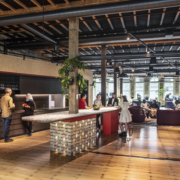Crafting a New Era of Workspaces: Cultivating Environments for Well-being and Sustainability
Building Review Journal speaks to Joanne Morris, Head of Design and Delivery for Asia, at Unispace about the intersection of contemporary workspace design, sustainability, and the imperative shift towards holistic, community-centric environments

In today’s swiftly evolving corporate landscape, the nexus between employee well-being, productivity, and environmental sustainability has become a pivotal focus for businesses worldwide. The seismic shift triggered by the COVID era has rendered traditional office setups obsolete. As we emerge into a post-pandemic world, the call is for adaptive, responsive workspaces that transcend the confines of home offices.
Biophilic Design: Transforming Workplaces for Wellness and Sustainability
In today’s fast-paced corporate environment, businesses are more than ever recognising the critical value of prioritising employee well-being and productivity. Unispace shares this view and believes it is critical to develop viable buildings and public spaces that contribute to resilient communities. Our method aims to reestablish the connection to nature and encourage biodiversity, particularly in the workplace, where people spend a substantial amount of time – essentially becoming their “second home.” Fostering such relationships positively impacts individual health and overall organisational resilience and success.
The emergence of a new type of workplace

The advent of COVID marked a transformative shift in the growth landscape, particularly in the context of work environments. The post-COVID era has brought about a significant transformation in workplace dynamics, making traditional office setups obsolete. The new approach requires offices to be adaptable and responsive to the changing needs of the workforce.
As we emerge from the pandemic, workspaces should go beyond what home offices offer, incorporating improved ergonomic design, attractive environments, increased social interaction, ample space for contemplation, and versatile micro-environments. The rationale behind daily commuting is now under scrutiny, prompting offices to articulate compelling reasons for in-person presence. Essentially, the modern office must evolve into a dynamic space that exceeds the expectations of a workforce influenced by pandemic experiences, highlighting its distinct advantages over remote work.
Our “Returning for Good” workplace insights report underscores that employees now have new or refined expectations, with collaboration and concentration standing out as the most crucial. Current workspaces must be flexible to accommodate all work modes, providing collaborative spaces, secluded work areas, routine workspaces, and even areas for focused learning. A significant portion (53%) of employees noted that their workplaces lack access to amenities that would enhance their well-being, such as prayer rooms, lactation spaces, and digital-free zones.
Wellness and connection with nature and community become of paramount importance

In response to the increasing acknowledgement of the importance of prioritising employees’ physical and mental well-being, businesses are exploring the potential of integrating green spaces and biophilic design into their workplaces. The impact of wellness on the design of workspaces is crucial as it addresses the diverse needs of individuals. It goes beyond creating functional offices; it involves shaping environments where people can genuinely live, work, play, heal, and learn. A workplace that promotes health and harmony can enhance employee satisfaction, productivity, and performance.
The trend towards holistic, healthy living and interior design that extends beyond aesthetics to encompass the well-being of the mind and body is emphasised in the report from the American Society of Interior Designers (ASID). Workspaces embracing this concept focus on creating environments that encourage physical activity, mental relaxation, social interaction, and personal growth. Recognising that a balanced and nurturing space contributes to employees’ happiness and increased productivity, this approach represents a profound shift in contemporary workspace design.
The need for biophilic design

In the commercial context, biophilic design revolves around viewing the office as a community, striving to establish workspaces that foster social integration and communal well-being. This design approach, gaining rapid popularity, draws inspiration from nature’s patterns, forms, and processes to craft environments that either mimic or incorporate natural elements. Research indicates that exposure to nature in design can alleviate stress, decrease blood pressure, and enhance cognitive function.
A favourable habitat, characterised by ecologically sound and productive environments, facilitates individuals in operating at their optimal potential. Additionally, it advocates for the use of sustainable materials and energy-efficient practices to reduce an organisation’s environmental impact.
Biophilic elements integrated into the workplace have the potential to enhance creativity and focus, leading to heightened productivity and job satisfaction. The inclusion of features like greenery, natural light, and outdoor connections not only improves the indoor air quality and energy efficiency of a building but also elevates the well-being of its occupants. In healthcare settings, design inspired by nature has been proven to expedite recovery times and enhance patient well-being.
Increasing focus on DEIB globally

Globally, organisations and governments strongly emphasise Diversity, Equity, Inclusion, and Belonging (DEIB) initiatives to cultivate inclusive environments where individuals from diverse backgrounds feel valued and empowered. Unispace collaborates with businesses worldwide, designing sustainable, adaptable, and innovative workplaces that align with current and future needs. The company adopts a holistic approach to decision-making, considering the entire life cycle of projects to minimise unintended downstream impacts and ensure alignment with sustainable design principles.
For our client Arup, a global specialist engineering firm that targeted the world’s most stringent sustainability accreditation, the Living Building Challenge, we followed sustainable and regenerative building practices to achieve their goals of creating one of the most sustainable workplaces in Aotearoa New Zealand.
Arup’s new workplace integrates net-positive sustainability and storytelling. Guided by Ngati Whatua Orakei (local iwi), the workplace is connected to the cultural, spiritual and historical context of New Zealand. Embracing Te Ao Maori, a holistic approach to Maori culture and way of thinking, Arup’s new workplace is embedded in the natural environment.
With te taiao (Natural World) and sustainability as the weave (raranga), the journey began by implementing design principles through the first stage and leading through procurement of local iwi and Maori businesses. It ended in the blessing and powhiri (welcome) for Arup whanau (extended family group) on opening day.
During the project, 90% of the materials we used were free of toxic ingredients, and 50% were sourced locally within New Zealand. We have also diverted 99% of waste from landfills. Using upcycled and salvaged materials, its kitchen bench top comprises 5,000 pieces of plastic waste.
Based on Arup’s post-occupancy survey, 100% of employees believe that the design of the office supports good employee well-being, boasting a 95% occupancy rate. It proves the success of Arup’s new workplace as a space that reduces stress, creates a sense of wellbeing, supports creativity and emotional resilience, and encourages employees back to the office.
Into the future
According to “Forefront: 2023 global life sciences benchmarking report”, which we published earlier this year, “Optimising energy and material usage” and “waste reduction/recycling” are currently the two most popular areas of sustainability investment right now and will remain the focus for the next five years.
It is vital to embody sustainability at the core of your business. One way we manage our carbon footprint is to ensure all vendors we work with hold sustainability certifications and are willing to collaborate to reduce embodied carbon on projects. 94% of our recent projects’ construction waste has been recycled and/or diverted from landfills. Over 30 completed projects have achieved sustainability certifications.
At its heart, sustainability entails creating a mobile, community-focused work environment that operates efficiently, reduces waste, ensures employee health and safety, and conserves energy.




